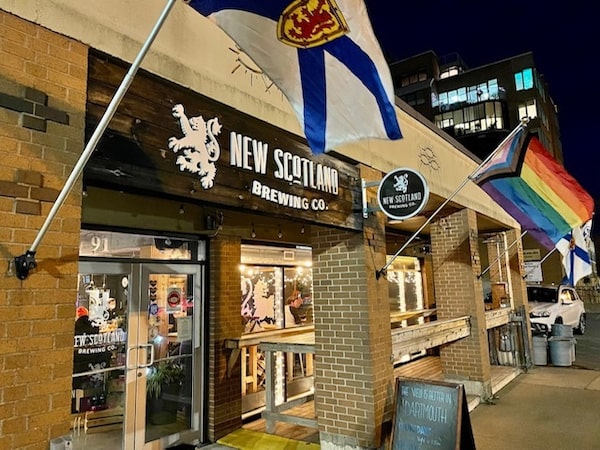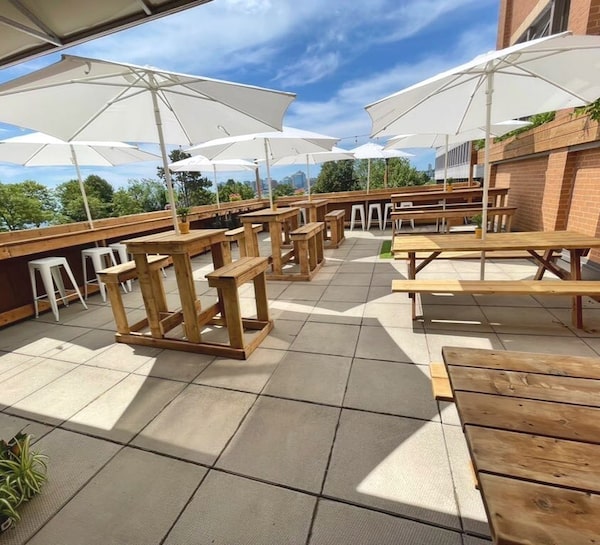
Brothers Scott and Kevin Saccary are moving into an 18,000-square-foot space complete with a rooftop patio along Prince Street in Dartmouth, N.S.Courtesy Scott Saccary
This summer, Scott Saccary and his brother and business partner, Kevin, will be open for business. They’re moving into an 18,000-square-foot space complete with a rooftop patio along Prince Street, a main drag in Dartmouth, N.S., which will house the pair’s two businesses under one roof – New Scotland Brewing Co. and New Scotland Clothing Co.
These brothers have always been the type of business people to jump into something when opportunity knocked – even if they didn’t quite know what they were getting into. It happened in 2016, when they were having a beer at a local pub and one said to the other, “Wouldn’t our [clothing] logo look great on a tap handle?” So they decided to open a brewery, despite having no idea how to brew beer. (They teamed up with brewmaster, Mike Gillespie, who did.)
Now the opportunity has come up to bring both businesses into the same location, creating a hybrid business space for locals and tourists alike along one of Dartmouth’s main streets, so “we jumped at it,” says Scott Saccary.
Many small businesses took a colossal hit throughout the pandemic, but now is a good time for them to return to Canada’s main streets, according to experts, as people are still moving into urban centres and need access to shops and services. Even business owners who may not have considered a main street storefront might find ripe opportunities now.
Just this month, RioCan Real Estate Investment Trust, which owns more than 200 retail spaces in Toronto, reported strong demand for retail space in the first quarter of 2022, with a committed occupancy rate of 97 per cent.
And those businesses that are fully e-commerce are still in need of a retail space, if only for their inventory, reports Colliers Canada, which recently reported that higher e-commerce sales are leading 55 per cent of retailers to reconfigure their existing physical units and show an increasing need for inventory space.

Scott Saccary said his new landlord for New Scotland Co. is conscientious about creating a local community.Courtesy Scott Saccary
The message of shopping and supporting local businesses was a common rally cry among Canadian business leaders throughout the pandemic, and this, coupled with people who have been cooped up on and off for two years, is likely to increase customers at main street businesses. U.S. research firm, Forrester, predicts that while e-commerce has dramatically increased in recent years, in-person shopping will still account for 72 per cent of the retail experience by 2024.
“People are tired of being at home and are looking to both get back out into their community and travel a bit,” says Tim Rissesco, chief executive officer of Downtown Dartmouth Business Commission. “Downtowns provide people with the opportunity to enjoy unique local experiences and finds.”
This is certainly the case in the West. Pent up demand from stir-crazy consumers is what’s lifting businesses along Calgary’s 17th Ave SW, says Tulene Steiestol, executive director of 17th Avenue Retail and Entertainment District Business Improvement Association.
“People want to get out, they want to socialize, they want to shop,” says Ms. Steiestol, “and we’re here for all of it.”
There is often little lag time between businesses closing and another opening as “we are a popular destination, we have a really great reputation, so if a business does leave then there is often someone waiting in the wings to scoop it up,” she explains.
This spring, “strong leasing activity that started in 2021 has continued into 2022,” says the Calgary Spring 2022 Retail Outlook report from Jones Lang LaSalle.
“Overall, local retailers remain optimistic about increased future sales fuelled by pent up demand,” the report says, noting that while rental rates are rising, they are still below pre-pandemic levels and foot traffic is increasing. In addition, downtown vacancy rates are around 6 per cent, while outside the core it’s 4 per cent.
“People have realized that these businesses are important and shopping local is crucial for that support and they want to do that,” adds Ms. Steiestol.
It also helps that many people are coming back to urban centres as offices slowly reclaim their workers.
According to last September’s PwC’s Canadian work force of the future survey, of employers that had yet to return to the workplace, “78 per cent expected to do so to at least some extent in the next three months.”
In Winnipeg, the picture in downtown is a slow return to work and there are still some questions about foot traffic for local businesses generated by office workers. But the long-term scenario seems more promising as “there’s a lot of momentum to recover,” says Loren Remillard, president and chief executive officer at The Winnipeg Chamber of Commerce.
In fact, Colliers, predicts that Canada’s retail vacancy is expected to remain stable at current levels, approximately 8.5 per cent nationally, over the next two years.
“What we’re seeing is that there is an appetite to live downtown and the people that take up residence in the centre want to be walking distance to the services they need and want, like shopping, groceries and restaurants,” he explains.
Indeed, despite the trend throughout the pandemic of people moving out to the suburbs in search of larger homes with more space and land, the populations of Canada’s downtown city centres continue to increase more rapidly than ever. From 2016 to 2021, the downtown populations of the large urban centres (100,000 people or more) grew faster (+10.9 per cent) than the urban centres as a whole (+6.1 per cent), according to a study by Statistics Canada.
Mr. Remillard also credits “motivated landlords” with aiding local businesses to either return to or try out a storefront on main streets. He suggests there may be opportunities for businesses that want to try having a central storefront but haven’t yet had the chance.
This was the case for Mr. Saccary, who says the new landlord for New Scotland Co. is conscientious about creating a local community that buys and sells to each other.
“He’s had buildings here for over 30 years and he’s seen downtown Dartmouth go through the best and the worst,” says Mr. Saccary, “so he’s really interested in creating this local feel, this sort of old European way of buying and selling and working with each other to stimulate the economy.”
“We’re so happy to be along for that ride,” he adds, “and, of course, to get our businesses all under one roof.”

New Scotland Brewing Co. added a rooftop patio to its location.Courtesy Scott Saccary